
Urtica ferox, commonly known as tree nettle and, in Māori, ongaonga, taraonga, taraongaonga, оr okaoka, is a species of nettle endemic to New Zealand. Unlike the other species in the genus Urtica found in New Zealand, all of which are herbaceous, ongaonga is a large woody shrub that can grow to a height of 3 m (9.8 ft), with the base of the stem reaching 12 cm (4.7 in) in thickness. It has large spines that can result in a painful sting that lasts several days.

Clianthus puniceus, common name kaka beak, is a species of flowering plant in the genus Clianthus of the legume family Fabaceae, native to New Zealand's North Island.

Pittosporum tenuifolium is a small evergreen tree endemic to New Zealand – up to 10 m (33 ft) – commonly known as kōhūhū and black matipo, and by other Māori names kohukohu and tawhiwhi. Its small, very dark, reddish-purple flowers generally go unnoticed, and are scented only at night. The Latin tenuifolium means "slender-leaved"

Pennantia baylisiana, commonly known as Three Kings kaikōmako or kaikōmako manawatāwhi (Māori), is a species of plant in the family Pennantiaceae. It is endemic to Manawatāwhi / Three Kings Islands, around 55 kilometres (34 mi) northwest of Cape Reinga, New Zealand. At the time of its discovery just one plant remained. This single tree grows on a scree slope inaccessible to browsing goats, and has been called "the world's loneliest tree". The species was discovered in 1945 by botanist Geoff Baylis and described in 1948, although it took decades before it was it was fully accepted as a distinct species of Pennantia. Although the only wild tree is female, it was successfully propagated from cuttings in the 1950s, one of which was induced to self-pollinate in 1985. Subsequent seed-grown plants have themselves set seeds, and the species has been replanted on the island, the adjoining mainland, and in public and private gardens around New Zealand.

Chionochloa rubra, known commonly as red tussock grass, is a species of tussock grass in the grass family, endemic to New Zealand.

Haloragis erecta, the shrubby haloragis, toatoa or erect seaberry, is a plant species that is endemic to New Zealand.
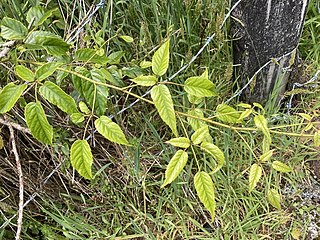
Rubus cissoides, commonly called bush lawyer or tātarāmoa in te reo Māori, is a species of flowering plant in the family Rosaceae, endemic to New Zealand. Alan Cunningham described R. cissoides in 1839. Plants of this species of are perennial scrambling vines with compound leaves with 3-5 leaflets each up to 15 cm long, reddish prickles on the branches, white flowers from September to November and red berries from December to April. The conservation status of R. cissoides is Not Threatened, it is widespread on all three main islands of mainland New Zealand, and it has been used by Māori as food, medicines and construction materials.
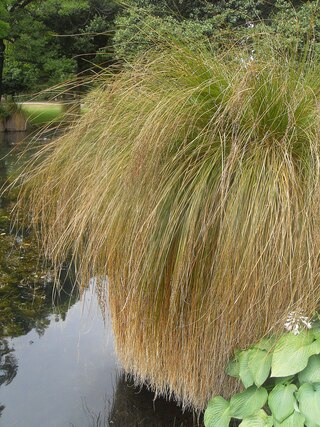
Carex secta is a sedge from the Cyperaceae family that is endemic to New Zealand. It grows in wetlands. Its Māori names include purei, pukio and makura.

Old man's beard is an invasive plant in New Zealand that affects indigenous biodiversity. It is declared an unwanted organism under the Biosecurity Act 1993 which means it cannot be sold, distributed or propagated.
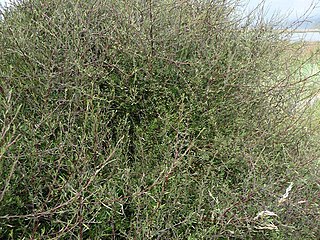
Plagianthus divaricatus or saltmarsh ribbonwood is a plant that is endemic to New Zealand. The Māori name is mākaka.

Clematis paniculata is a species of flowering plant in the buttercup family Ranunculaceae. It is one of seven species of clematis native to New Zealand. C. paniculata is the most common of these, and is widespread in forests throughout the country.

Austroderia richardii, syn. Cortaderia richardii, is a species of flowering plant in the family Poaceae. It is an evergreen perennial grass. The genus Austroderia is often confused with "pampas grass", which usually refers to Cortaderia selloana. "Early pampas-grass" is a more specific name. The name "tussock grass" may also be found. The Maori name is "toetoe". It is one of five species commonly called toetoe in the genus Austroderia that are endemic to New Zealand. It occurs in the South Island and possibly also in the North Island. It is also an introduced species in Tasmania, Australia.

Olearia paniculata, commonly called akiraho, is a species of shrub or tree in the family Asteraceae, found only in New Zealand. The tree can grow to 6 metres high, and has yellow-green, oval-shaped leaves, with white undersides and wavy margins.

Parsonsia heterophylla, commonly called New Zealand Jasmine or Kaihua, is a climbing plant endemic to New Zealand. It was first described by Alan Cunningham in 1839.

Ozothamnus leptophyllus, commonly known as tauhinu or cottonwood, is an endemic shrub of New Zealand. Tauhinu is fast-growing, reaching 2 metres in height and is a common plant of coastal farmland. This species is host to the larvae of the New Zealand endemic moth Homoeosoma anaspila.

Disphyma australe is a species of flowering plant in the family Aizoaceae and is endemic to New Zealand. It is a prostrate, succulent annual shrub or short-lived perennial plant with stems up to 2 m long, leaves that are three-sided in cross-section with a rounded lower angle, and white to deep pink daisy-like flowers that are 2–4 cm (0.79–1.57 in) in diameter with 3–5 rows of petals and multiple stamens. Disphyma australe is a coastal plant and therefore can be found at cliff faces, gravel beaches, salt meadows and estuaries.
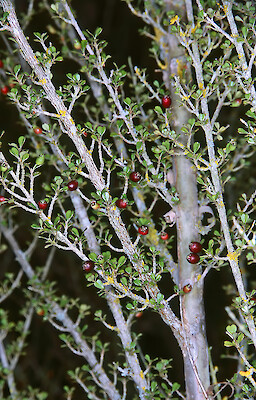
Lophomyrtus obcordata, commonly known by its Māori name rōhutu or tutuhi, is a species of flowering plant in the family Myrtaceae. It is endemic to New Zealand, usually found in lowland forest. Lophomyrtus comes from the ancient Greek lóphos (crest), meaning bunches; and Myrtus (myrtle) meaning myrtle tree. Obcordata is associated with a heart-shaped leaf, attached to the peduncle by the pointed end.
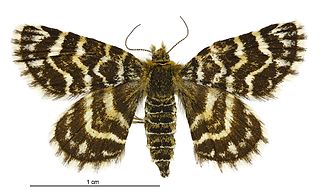
Notoreas hexaleuca is a species of moth in the family Geometridae. This species is endemic to New Zealand.

Ileostylus micranthus, commonly known as green mistletoe pikirangi; pirinoa; pirirangi; pirita; small-flowered mistletoe, is a species of mistletoe in the family Loranthaceae.

Anaphalioides bellidioides, commonly known as the New Zealand everlasting daisy, is a native vascular shrub in the genus Anaphalioides, found distributed throughout New Zealand.




















